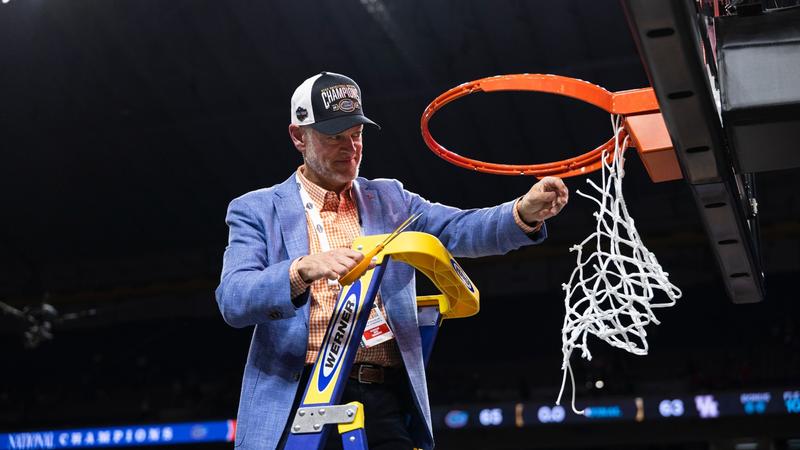Changing Times: Gators AD Scott Stricklin Discusses Wide Range of Topics as Revenue-Sharing Era Starts
If a snapshot of the industry could have been taken that day and compared to a portrait today, most would assume the photos featured two completely different subjects, such as MLB slugger Barry Bonds at the start of his career and the end of his career.
Besides the standard role of the job – managing personnel and budgets, raising money, developing strategic plans, growing fan interest, etc. – Stricklin was charged with leading the Gators through the COVID-19 pandemic in 2020. And since July 2021, he has guided UF’s athletic department in a landscape dominated by NIL (name, image and likeness) and constant player movement in the transfer portal.
The 55-year-old Stricklin has understandably sprouted a few gray hairs in less than a decade on the job.
“It’s not hyperbole to say it’s been unprecedented change in a relatively short period of time,” he said. “Anytime you are leading and navigating through change, it’s challenging.”
In an interview Wednesday morning with a group of beat reporters, Stricklin didn’t hesitate when asked about the most difficult part of his job the past four years.
“People crave certainty. And that’s really an impossible thing to give people,” he said. “They will settle for clarity, but even clarity has been hard to provide at times. It’s really not even starting with ’21, but it goes back to Covid. If you think about it, college athletics has been on a kind of six-month spin cycle. Things evolve like every six months, seemingly in the last five years.”

Next up for Stricklin and his fellow athletic directors: navigating the revenue-sharing era of college athletics, which is set to go into effect July 1. The historic agreement is a result of the recent House vs. NCAA settlement that significantly alters how student-athletes are compensated and how the NCAA operates.
The revenue-sharing era is set to change the landscape of college athletics like few moments in the NCAA’s history.
Stricklin is hopeful that after four years of what many in the industry have referred to as the “Wild, Wild West” – unchecked pay-for-play payments by boosters and NIL collectives, rampant player movement and a tidal wave of lawsuits – that an era of stability is on the horizon.
As part of the House vs. NCAA settlements, the NCAA will pay approximately $2.8 billion in back damages over the next 10 years to student-athletes who competed from 2016 through the present day. Meanwhile, each school can pay its student-athletes up to a specific limit. The annual cap is expected to start at approximately $20.5 million per school in 2025-26 and increase annually over the decade-long deal. These new payments are in addition to scholarships and other benefits the athletes already receive.
“My sense is that it has a chance, for the first time since ’21, to have some kind of consistent way to the way we operate relative to the benefits we provide athletes,” Stricklin said. “What’s different about this is this new system is going to be a part of a federal-court approved plan and approach, a settlement that both sides agreed to what the structure would look like, both sides meaning the plaintiffs, being the athletes, and the defendants, being the conferences and the NCAA.
“That hasn’t existed up to this point. The enforcement piece is obviously going to be a really key component to making sure this thing works as envisioned.”
NIL payments will be administered by software created by Deloitte, a system referred to as “NIL Go” within the industry. In addition, former MLB executive Brian Seeley was recently hired as CEO of the new College Sports Commission, the branch of the new ecosystem tasked with overseeing enforcement.
As potential clarity starts to emerge, Stricklin knows of one certainty among the Power 4 schools.
“Everyone is going to go all in on football,” he said.
Stricklin covered a myriad of topics on Wednesday, and for deeper clarity, here is a Q&A featuring some of the significant questions surrounding the immediate future of college athletics:
Q: The 105-roster limit for football is an overriding topic among coaches. What is UF’s approach to roster numbers across all sports?
A: We will have the max on our rosters that are allowed. We won’t be scholarshipping every roster, but we’ll probably add over 50 new scholarships to over what we have done traditionally. [Stricklin later clarified that UF’s scholarship total will increase from around 265 to 320 and can be split to impact more student-athletes.]
Q: How will the revenue be shared among UF’s athletic programs?
A: The sports that generated revenue will get some portion of rev share, proportionate to what they generate. That’s five or six of our sports that generate some kind of revenue. But every sport at the UAA will receive – if they don’t get rev share – they will at least receive a benefit in the form of extra scholarships. Every sport will have more support coming to the athletes.
Q: What has been the reaction from sports that may not generate revenue, such as the Olympic sports?
A: For years, everyone understood that football drove a lot of the engine behind what funded everything. I think there is an understanding that this is a different world, and we have an opportunity to share revenue, and it makes sense that we’re going to share it proportionate to how it’s generated. That is not a concern. They are getting something. Their athletes are benefiting. We really didn’t [get pushback]. The University of Florida still supports its programs at a pretty high level, and I think our coaches and staff understand that, and they also understand we’re in a new reality.

Q: What about concerns in the industry?
A: The concerns are that there’s an opportunity for inequality among sports at different schools. Some schools may value women’s basketball more than others, or baseball more than others, or gymnastics more than others. It’s going to make some of those playing fields even more uneven. My guess is every school is going to do everything it can to support football and men’s basketball, but even then, you’ve got some schools that don’t have football. They can really go all in on men’s basketball. It is what it is.
Q: What is the role now of the NIL collective Florida Victorious?
A: They still have some opportunities to support our athletes. They have adapted continually, and I think they will have to continue to adapt into more of a for-profit, almost a marketing agency, helping connect athletes to deals to be effective. The day of pulling a bunch of donor dollars and passing it out is going to be a lot harder in the new settlement world. But they have done a phenomenal job. They’ve worked their tail off and have really benefited our teams and our athletes.
Q: What are your thoughts on a program such as Texas Tech softball, which made the WCWS after investing in a significant payroll?
A: I can tell you that there are a lot of SEC baseball schools that did significant investments and didn’t end up where they wanted to be, and meanwhile, Murray State, I guarantee you, has very little NIL, and they went to Omaha. You want to put as many resources as you can behind it because it gives you the best chance to be successful, but it doesn’t guarantee anything.
Q: What have you seen from your coaches these last few years?
A: Coaches have done a great job of adjusting. In general, what they have had to deal with, and how their world has changed so quickly, it’s a huge credit they have been able to navigate that. They have all learned to live in this new system.
Q: What do you see as a significant factor for the revenue-sharing era to work?
A: Is there swift justice for [breaking the agreement?] I think we’re all hoping everybody plays by the rules, but understanding human nature, there’s probably some people that are going to test that. If someone is found circumventing the cap, there’s got to be swift justice. I don’t know Brian Seely, but I’m encouraged by his background, having been part of enforcement at the Major League Baseball level. Even some of the decisions that he has handed down have been pretty punitive and has sent strong messages.
Q: What went into a 5% reduction across all departments and sports in the 2025-26 UAA budget?
A: We tightened our belts in some areas across the department. And then we have a lot of services that we have paid the university for, and there’s some of those that we are reassessing: could we come up with a way the university could give us a break on some of those [parking lots, utility costs, etc.].
Q: How do you raise money to revamp Ben Hill Griffin Stadium in an era when you now are starting to pay student-athletes more than $20 million per year?
A: That’s part of the trick. There’s no easy solutions. There is a demand for what is provided when people come to a football game at Ben Hill Griffin Stadium. And that demand continues seemingly to grow. I think it’s going to have a chance there to be a multiplier off that just because I think our program is now in a position of where it’s going to be a lot of fun – even more fun coming to the Swamp than it has been. We’ve got to be really creative and aggressive and also come up with a really good plan. The fact of the matter is, if it’s the right mix of premium inventory and fan amenities, people will pay for that. And they’ll pay for it willingly. We saw that at the Condron Ballpark. Our game day revenue from the last year at McKethan to last year at the ballpark was 7x. A lot more people are coming out, but they’re willing to pay more. It just drives more revenue. That’s why it’s really important that you just don’t slap paint on this thing, and you have a plan that keeps what’s special about the Swamp but extends the useful livelihood of this facility for another 50 years, so multiple generations of Gators can keep coming and experience that.
Q: What is the potential for naming rights on the stadium and other sponsorships, such as jersey and field decals?
A: There’s certainly some spaces where you can do that. We’ll turn over every stone to find new revenue. Pro sports is a great model. They have figured out a lot, and there’s a lot we can learn from how they have operated in their revenue generation. Editor’s note: While the NCAA has approved field sponsorships, jersey sponsorships are not an option under current rules.

Q: We’re seeing some schools eliminate sports. Any thoughts on that in the SEC or at UF?
A: It has not come up other than in passing, what would happen. There would have to be a nationwide movement to eliminate sports, in my opinion, before it got to the SEC and certainly before it got to the University of Florida. There’s no plans or intent to do that. The sports people would target … they don’t really save you a lot of money to eliminate it. To really get cost savings, you are going to have to do something dramatic, where you wipe out half your sports program. I don’t know if Congress is ever going to do something to codify this settlement – there’s certainly hope that they will – but I think one thing that is probably bipartisan is the support of the Olympic sports movement in our country. If there was a wave of schools drastically cutting their sport offerings, I think if there would be anything to get Congress to act, that would be it.
Q: What about football coaches’ concerns about the 105-roster limit?
A: It’s part of a federal settlement. We’re all going to have to adapt, including coaches. They may have to change how they practice. The sport’s evolved, it’s become safer. This may drive innovation to keep it more safer, to keep guys out there even longer. People will figure it out.
Q: For those who doubt the new system will work in regards to enforcement, what is your view?
A: It works in pro sports. Now there is a huge difference in that in pro sports, for the most part, except for free agency, the players who go into that system, the teams are selecting them. And in college athletics, the players are selecting the teams, which leads to recruiting, which leads to a lot of the ills that face college athletics. If that system were flipped, if there was some way where the schools selected the kids instead of the other way around, so many of the lawsuits and issues that college athletics has could be solved overnight. And a lot of the runaway expenses would be solved overnight, because we spend money that people outside criticize college athletics for spending, because we have to recruit. But if we can somehow mirror the enforcement mechanism, they have to prevent salary cap circumvention in pro sports, then this thing has a chance to work.
Q: Finally, thoughts on the SEC’s desire to expand its involvement in the College Football Playoff?
A: More is better. In the SEC, every sport we sponsor, at minimum 50 percent of our teams have a meaningful postseason opportunity except in the one that generates the most interest. Bowl games have been great for college football for a long time, but in this day and age, a meaningful postseason opportunity is a CFP game. The more that can be opened up, the better.
Source link
editor's pick
latest video
Sports News To You
Subscribe to receive daily sports scores, hot takes, and breaking news!




